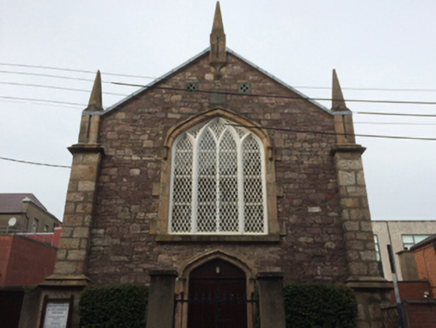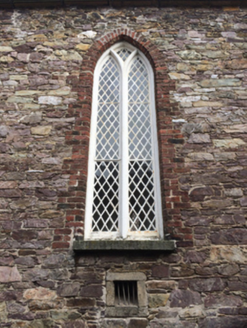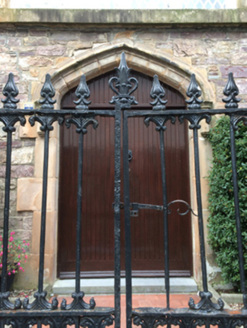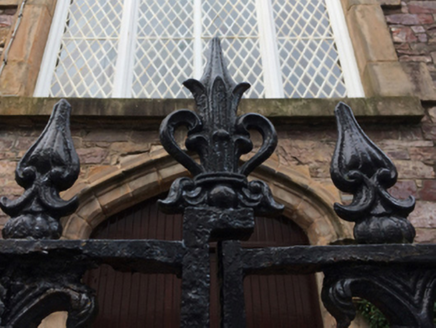Survey Data
Reg No
15503042
Rating
Regional
Categories of Special Interest
Architectural, Artistic, Historical, Scientific, Social
Previous Name
Wexford Presbyterian Church
Original Use
Church/chapel
In Use As
Church/chapel
Date
1840 - 1845
Coordinates
304940, 121832
Date Recorded
16/06/2005
Date Updated
--/--/--
Description
Detached single-bay (three-bay deep) double-height gable-fronted single-cell over basement Presbyterian church, designed 1843; dated 1843, on a rectangular plan. Pitched (gable-fronted) slate roof with clay ridge tiles, cut-granite coping to gable to entrance (south) front with cut-granite obelisk pinnacle to apex, and cast-iron rainwater goods on cut-granite eaves retaining cast-iron downpipes. Part repointed coursed rubble stone wall to front (south) elevation with cut-granite obelisk pinnacle-topped cut-"Old Red Sandstone" stepped piers to corners; coursed rubble stone surface finish (remainder). Tudor-headed door opening with cut-limestone step threshold, and block-and-start surround with hood moulding on engaged octagonal label stops framing replacement timber boarded or tongue-and-groove timber panelled double doors having overpanel. Tudor-headed window opening below cut-limestone date stone ("1843") with cut-granite sill, timber mullions, and block-and-start surround with hood moulding on engaged octagonal label stops framing fixed-pane fittings having lattice glazing bars. Pointed-arch window openings with cut-granite sills, timber Y-mullions, and red brick block-and-start surrounds framing fixed-pane fittings having lattice glazing bars. Full-height interior with timber boarded wainscoting supporting timber dado rail, central aisle between roll topped timber panelled pews, timber panelled pulpit on an octagonal plan, and segmental vaulted ceiling on moulded plasterwork cornice. Set back from line of street with rendered piers to perimeter having concrete capping supporting cast-iron double gates.
Appraisal
A church erected to a design by Thomas Willis (c.1782-1864) representing an important component of the mid nineteenth-century ecclesiastical heritage of Wexford with the architectural value of the composition, 'a simple though shapely [building] handsomely decorated with closely clinging ivy' (Bassett 1885, 77), confirmed by such attributes as the compact rectilinear plan form; the construction in a puce-coloured conglomerate stone offset by silver-grey granite or red brick dressings producing a mild polychromatic palette; the "pointed" profile of the openings underpinning a stolid Georgian Gothic theme with those openings showing pretty lattice glazing patterns; and the polygonal pinnacles embellishing the roofline. Having been well maintained, the elementary form and massing survive intact together with substantial quantities of the original fabric, both to the exterior and to the restrained interior where contemporary joinery; and sleek plasterwork refinements, all highlight the modest artistic potential of a church forming part of a self-contained group alongside the adjacent post office (see 15503043) with the resulting ensemble making a pleasing visual statement in Anne Street: meanwhile, a benchmark remains of additional interest for the connections with cartography and the preparation of maps by the Ordnance Survey (established 1824).





























